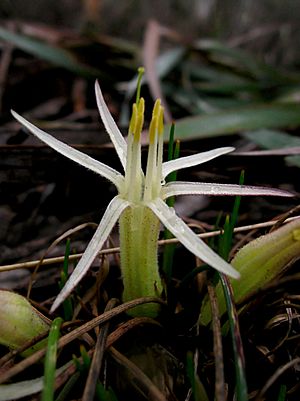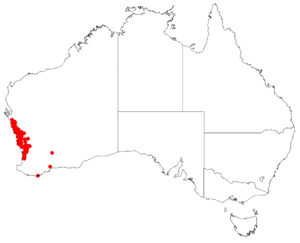Conostylis androstemma facts for kids
Quick facts for kids Conostylis androstemma |
|
|---|---|
 |
|
 |
|
| Scientific classification | |
| Genus: |
Conostylis
|
| Species: |
androstemma
|
 |
|
| Occurrence data from AVH | |
| Synonyms | |
|
Androstemma junceum Lindl. |
|
Conostylis androstemma is a special plant often called trumpets. It's a type of plant that grows in clumps and lives for many years. It belongs to the Haemodoraceae family, which includes many interesting plants. You can only find this plant in the southwestern part of Western Australia. These plants usually grow to be about 10 to 30 centimeters tall. They show off their pretty cream or pale yellow flowers from May to August.
Contents
What Does the Trumpet Plant Look Like?
The Conostylis androstemma has green leaves that are smooth and don't have any hairs. These leaves are shaped like thin tubes, about 10 to 30 cm long and only 1 mm wide.
Its Unique Flowers
The flowers of the trumpet plant are cream to pale yellow. They are covered in tiny hairs and are shaped like a tube, usually straight. This tube can be 30 to 50 mm long. The flower has six parts called stamens, all at the same level. These flowers bloom from May to August each year.
How it Survives Fire
After a bushfire, this amazing plant can grow back! It has special underground stems called rhizomes. These rhizomes help the plant resprout and come back to life, even after a fire has passed through.
How to Tell it Apart
It's easy to tell Conostylis androstemma apart from a similar plant called Conostylis argentea. The main difference is its smooth, hairless, tube-shaped leaves.
Where Does the Trumpet Plant Live?
This plant likes to grow in specific places. You can find it in rocky areas with laterite gravel. It also grows in yellow sand on hillsides and the tops of hills.
Where Can You Find It?
The trumpet plant lives in the southwestern part of Western Australia. Its range stretches from Kalbarri National Park all the way down to Perth and York.
How it Got Its Name
The Conostylis androstemma has an interesting history with its name.
Early Discoveries
In 1840, a botanist named John Lindley first described this plant. He called it Androstemma junceum in his book, A Sketch of the Vegetation of the Swan River Colony.
Renamed by a Famous Botanist
Later, in 1873, another famous botanist named Ferdinand von Mueller studied the plant. He decided it belonged in the genus Conostylis. So, he renamed it Conostylis androstemma in his work called Fragmenta Phytographiae Australiae.

